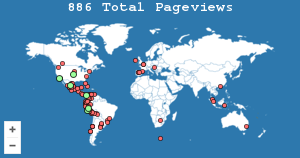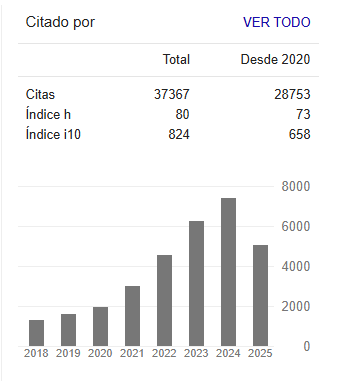Actitudes proambientales en segmentos de consumidores mexicanos y colombianos
Resumen
El cambio climático ha influido en la formación de nuevos segmentos del mercado constituidos por consumidores preocupados por el medio ambiente. El objetivo de esta investigación es caracterizar perfiles de consumidores a partir de sus actitudes proambientales. La investigación tiene un enfoque cuantitativo, de carácter exploratorio, recopila información de 775 consumidores mexicanos y colombianos para realizar una secuencia de análisis econométrico; factorial exploratorio y confirmatorio, clúster jerárquico y k-medias. Se identificaron siete segmentos de consumidores denominados como: cafés egoístas, verde intencionado, verde indiferente, verde desinformado, verde activo, verde contradictorio y verde intelectual. Se concluye que existe heterogeneidad entre los consumidores mexicanos y colombianos, que van desde los más accionarios -actitudes proambientales con componentes conductuales- hasta aquellos que exhiben niveles altos en actitudes contra ambientales, asimismo los perfiles de los consumidores diferenciados permitirán desarrollar estrategias para la segmentación de mercado centradas en actitudes favorables al ambiente, lo cual puede ser útil para posicionar y reposicionar productos.
Citas
Aertsens, J., Verbeke, W., Mondelaers, K., & Van Huylenbroeck, G. (2009). Personal determinants of organic food consumption: a review. British Food Journal, 111(10), 1140-1167. https://doi.org/10.1108/00070700910992961
Afonso, C., Gavilan D., García-Madariaga J., & Gonçalves H.M. (2018). Green Consumer Segmentation: Managerial and Environmental Implications from the Perspective of Business Strategies and Practices. In: Leal-Millan A., Peris-Ortiz M., Leal-Rodríguez A. (eds) Sustainability in Innovation and Entrepreneurship. Innovation, Technology, and Knowledge Management. (pp.137-151). Springer.
Alavi, M., Visentin, D.C., Thapa, D.K., Hunt, G.E., Watson, R., & Cleary, M. (2020). Chi-square for model fit in confirmatory factor analysis. J Adv Nurs, 76(9), 2209-2211. https://doi.org/10.1111/jan.14399
Amezcua, B., Briseño, A., Ríos, T. y Ayala, E. (2018). La disposición a pagar más por productos vinculados a la RSE: evidencia de un análisis conjunto en México. Contaduria y Adm., 63(2), 1-21. http://dx.doi.org/10.22201/fca.24488410e.2018.1013
Amin, S., & Tarun, M.T. (2021). Effect of consumption values on customers’ green purchase intention: a mediating role of green trust. Social Responsibility Journal, 17(8), 1320-1336. https://doi.org/10.1108/SRJ-05-2020-0191
Azjen, I. (1991). The Theory of Planned Behavior. Organ Behav Hum Decis Process, 50(2), 179-211. https://doi.org/10.1016/0749-5978(91)90020-T
Alzaidi, S.M., & Iyanna, S. (2022). Developing a conceptual model for voluntary pro-environmental behavior of employees. Social Responsibility Journal, 18(2), 441-452. https://doi.org/10.1108/SRJ-11-2020-0477
Balderjahn, I. (1988) Personality Variables and Environmental Attitudes as Predictors of Ecologically Responsible Consumption Patterns. J Bus Res., 17(1), 51-56. https://doi.org/10.1016/0148-2963(88)90022
Barber, N.A., Taylor, C.D. & Venkatachalam, V. (2016). Does the Product Really Matter? A Look at Mainstream Pro-Environmental Consumption Behavior. Journal of Food Products Marketing, 22(5), 521-554. https://doi.org/10.1080/10454446.2016.1141140
Bianchi, E.C., Ferreyra, S., & Kosiak de Gesualdo, G. (2013). Consumo responsable: diagnóstico y análisis comparativo en la Argentina y Uruguay. Escritos Contables y de Administración, 4(1), 43-79. https://doi.org/10.52292/j.eca.2013.280
Bubnova, I., Khvatova, M., Chernik, V., Popova, O., Prokopyev, A., Naumov, P. & Babarykin, O. (2018). Research of Professional Activity Features of Ecologist at Carrying Out Public Ecological Examination. Ekoloji, 27(106), 999-1006. http://www.ekolojidergisi.com/download/research-of-professional-activity-features-of-ecologist-at-carrying-out-public-ecological-5521.pdf
Carpenter, J., Moore, M., Doherty, A., & Alexander, N. (2012). Acculturation to the global consumer culture: a generational cohort comparison. J. Strateg., 20(5), 411–423. https://doi.org/10.1080/0965254X.2012.671340
Caniëls, M. C. J., Lambrechts W., Platje J., Motylska-Kuźma A., & Fortuński B. (2021). Impressing my friends: the role of social value in green purchasing attitude for youthful consumers. Journal of Cleaner Production, 303(20), 126993. https://doi.org/10.1016/j.jclepro.2021.126993
Castanedo, C. (1995). Escala para la evaluación de las actitudes pro-ambientales (EAPA) de alumnos universitarios. Rev. Complut. de Educ., 6(2), 253-278. https://dialnet.unirioja.es/servlet/articulo?codigo=150169&orden=1&info=link
Castro, R., (2000) Naturaleza y funciones de las actitudes ambientales, Estudios de Psicología, 22(1), 11-22. https://doi.org/10.1174/021093901609569
Coşkun, A., & Yetkin Özbük, R.M. (2019). Environmental segmentation: young millennials’ profile in an emerging economy, Young Consum., 20(4), 359-379. https://doi.org/10.1108/YC-12-2018-0912
Escobar, D. M. y Fontalvo, M.C. (2020). Consumo responsable, práctica de una ciudadanía ambiental. Revista Sextante, 22, 25-32. http://www.sextante-ensb.com/index.php/inicio/article/view/71/94
Finisterra do Paço, A., Barata, M. L., & Filho, W. (2009). Identifying the green consumer: A segmentation study. J. Target. meas. anal. mark., 17(1), 17–25. https://doi.org/10.1057/jt.2008.28
Golob, U, & Kronegger, L. (2019). Environmental consciousness of European consumers: A segmentation-based study. Journal of Cleaner Production, 221(1), 1-9. https://doi.org/10.1016/j.jclepro.2019.02.197
Granato, D., Santos, J. S., Escher, G. B., Ferreira, B. L., & Maggioc, R. M. (2018). Use of principal component analysis (PCA) and hierarchical cluster analysis (HCA) for multivariate association between bioactive compounds and functional properties in foods: A critical perspective. Trends Food Sci Technol., 72, 83-90, https://doi.org/10.1016/j.tifs.2017.12.006
Grunert, S. C., & Juhl, H. J. (1995). Values, environmental attitudes, and buying of organic foods. J Econ Psychol., 16(1), 39–62. https://doi.org/10.1016/0167-4870(94)00034-8
Jaiswal, D., Kaushal, V., Singh, P.K., & Biswas, A. (2021). Green market segmentation and consumer profiling: a cluster approach to an emerging consumer market, Benchmarking: An International Journal, 28(3), 792-812. https://doi.org/10.1108/BIJ-05-2020-0247
Jakubowska, D., y Radzymińska, M. (2019). Health and environmental attitudes and values in food choices: a comparative study for Poland and Czech Republic. Oecon. Copernic., 10(3), pp. 433–452. https://doi.org/10.24136/oc.2019.021
Kwon, J. y Ahn, J. (2021). Características sociodemográficas y comportamiento de consumo verde en los países en desarrollo: el caso de Malasia. Social Responsibility Journal, 17(8), 1213-1231. https://doi.org/10.1108/SRJ-02-2020-0071
Lee, Y.J., & Haley, E. (2020). How Do Generational Differences Drive Response to Social-Issue Ads? The Effect of Value Orientations Across Generations in the U.S. J Advert Res., 60(3), 270–289. https://doi.org/10.2501/JAR-2019-013
Li, J.-Y., Overton, H. & Bhalla, N. (2020). Communicative action and supportive behaviors for environmental CSR practices: an attitude-based segmentation approach, Corp. Commun., 25(2), 171-186. https://doi.org/10.1108/CCIJ-04-2019-0045
Maloney, P.M., & Ward, M.P. (1973) Ecology: Let’s her from the people. An objective scale for the measurement of ecological attitudes and knowledge. Am Psychol., 28(7), 583–586. https://doi.org/10.1037/h0034936
Maskey, R., Fei, J. & Nguyen, H. (2018). Use of exploratory factor analysis in maritime research. Asian J. Shipp. Logist, 34(2) 91-111, https://doi.org/10.1016/j.ajsl.2018.06.006
Rajabi, A., Eskandari, M., Ghadi, M. J., Li, L., Zhang, J., & Siano, P. (2020). A comparative study of clustering techniques for electrical load pattern segmentation. Renew. Sust. Energ, 120, 109628, https://doi.org/10.1016/j.rser.2019.109628
Reimers, V., Magnuson, B., & Chao, F. (2017). Happiness, altruism and the Prius effect: How do they influence consumer attitudes towards environmentally responsible clothing? J. Fash. Mark. Manag., 21(1), 115-132. https://doi.org/10.1108/JFMM-07-2016-0053
Salam, MT., Smith, KT & Mehboob, F. (2022). Purchase intention for green brands among Pakistani millennials. Social Responsibility Journal, 18(3), 469-483. https://doi.org/10.1108/SRJ-08-2020-0341
Salgado-Beltrán, L. (2019) Segmentación de los consumidores de alimentos orgánicos según sus actitudes, valores y creencias ambientales. Contaduría y Adm., 64(2), 1-22. http://dx.doi.org/10.22201/fca.24488410e.2018.1491
Sheoran, M. y Kumar, D. (2022). Evaluación comparativa de las barreras del comportamiento sostenible del consumidor. Social Responsibility Journal, 18(1) 19-42. https://doi.org/10.1108/SRJ-05-2020-0203
Singhal, A., & Malik, G. (2018) The attitude and purchasing of female consumers towards green marketing related to cosmetic industry. J. sci. technol.,12(3), 514-531. https://doi.org/10.1108/JSTPM-11-2017-0063
Speckemeier, L. & Tsivrikos, D. (2021). Power on environmental emotions and behavior.Social Responsibility Journal, 17(7), 937-951. https://doi.org/10.1108/SRJ-05-2020-0182
Taber, K.S. (2018). The Use of Cronbach’s Alpha When Developing and Reporting Research Instruments in Science Education. Res Sci Educ, 48, 1273–1296. https://doi.org/10.1007/s11165-016-9602-2
Van Liere, K.D. & Dunlap, R.E. (1980) The social Bases of Enviromental Concern: A Review of Hypotheses, Explanations and Empirical Evidence. Public Opin Q., 44(2), 181-197. https://www.jstor.org/stable/2748427
Watkins, M. W. (2018). Exploratory Factor Analysis: A Guide to Best Practice. Journal of Black Psychology, 44(3), 219–246. https://doi.org/10.1177/0095798418771807
Wut, TM., Ng, P., Kan, H.-KM & Fong, CS (2021). Does gender matter? Attitude towards waste charging policy and pro-enviromental behaviors. Social Responsibility Journal, 17(8), 1100-1115. https://doi.org/10.1108/SRJ-03-2020-0102
Ziaei-Bideh, A. & Namakshenas-Jahromi, M. (2020). Profiling Green Consumers with Data Mining. In Consumer Behavior and Marketing; IntechOpen: London, UK.

Esta obra está bajo licencia internacional Creative Commons Reconocimiento-NoComercial-CompartirIgual 4.0.








.png)






























